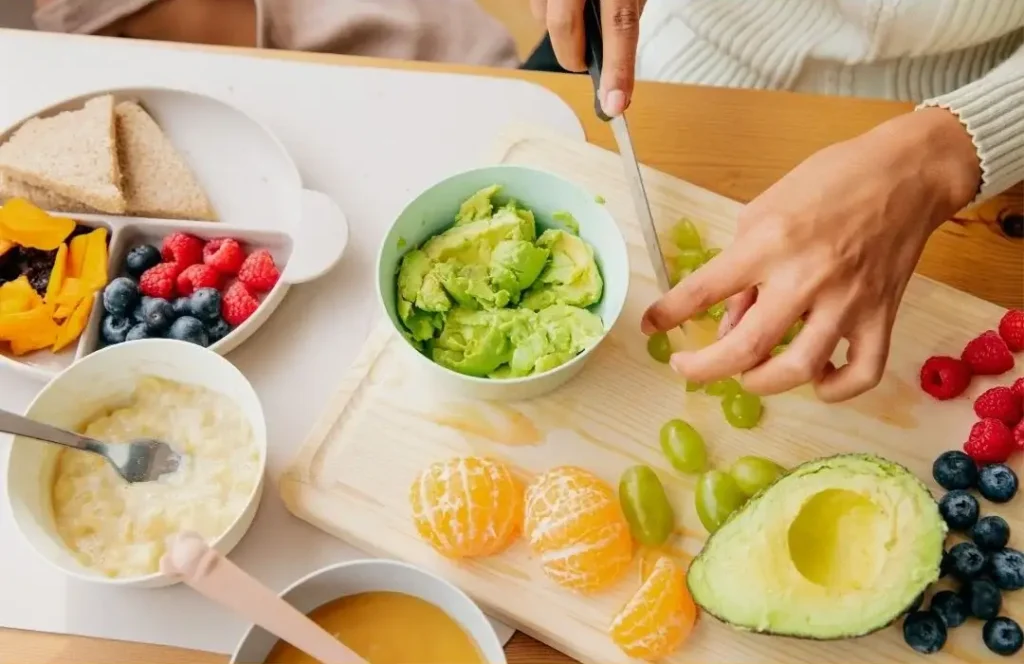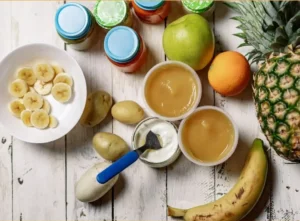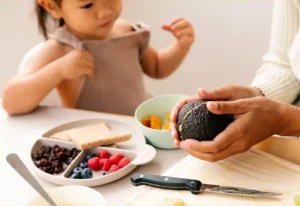Welcome to our website. If you are searching the knowledge about baby foods accordin
g to their various ages, you are at the right place. We have prepared some baby food charts according to the ages which will help you better.0 to 3 Months Baby Food Chart

Weeks 1-4: Breast Milk Feeding
- Breast Milk: Newborns should ideally be exclusively breastfed. Feed on demand, whenever the baby shows hunger cues (rooting, sucking on fists, or crying). Aim for 8-12 feedings per day.
- Formula Feeding: If you’re using formula, follow the instructions on the packaging for the appropriate amount. Generally, newborns drink about 2-3 ounces (60-90 ml) per feeding, every 2-3 hours.
Weeks 5-8: Breast Milk Feeding
- Continue to feed breast milk or formula every 2-3 hours, adjusting the quantity as your baby’s appetite grows. Most newborns will gradually increase to 3-4 ounces (90-120 ml) per feeding.
Weeks 9-12: Breast Milk Feeding
- Your baby may begin to show signs of increased appetite. Continue feeding every 2-3 hours, and the quantity may increase to 4-5 ounces (120-150 ml) per feeding.
In this article, you will read
0 to 6 months baby food chart
0 to 1 Month: Breast Milk or Formula
- Newborns should be exclusively breastfed or formula-fed. Feed your baby whenever they show hunger cues, which could be every 2-3 hours. Typically, they may consume about 2-3 ounces (60-90 ml) per feeding.
1 to 2 Months: Breast Milk or Formula
- Continue exclusive breastfeeding or formula feeding. Babies may gradually increase their intake to about 3-4 ounces (90-120 ml) per feeding. Feed on demand, usually every 2-3 hours.
2 to 4 Months: Breast Milk or Formula
- Still, breast milk or formula is the primary source of nutrition. Babies may consume around 4-5 ounces (120-150 ml) per feeding every 3-4 hours.
4 to 6 Months: Introduction of Solid Foods
- Around 4-6 months, you can begin to introduce solid foods as your baby shows signs of readiness. Start with single-grain infant cereal mixed with breast milk or formula. Begin with a small spoonful and gradually increase.
- Introduce apples, pears, bananas, and vegetables such as sweet potatoes, carrots, and peas.
- Continue breastfeeding or formula feeding alongside solids.
- Gradually increase the variety of foods and the thickness of the purees as your baby becomes more accustomed to eating.

4 months baby food chart India
Weeks 16-17: Introduction of Solid Foods
Note: Breast milk or formula should continue to be the primary source of nutrition at this stage.
Day 1-2: Single-Grain Cereal (Rice or Oatmeal)
- Mix 1-2 teaspoons of rice cereal with breast milk or formula to make a thin, runny consistency. Offer a small amount with a spoon.
Day 3-4: Rice Cereal
- Continue with rice cereal but gradually make it slightly thicker.
Day 5-6: Rice Cereal
- Increase the quantity of rice cereal to around 2-3 tablespoons mixed with breast milk or formula.
Weeks 18-19: Introduction of Pureed Fruits and Vegetables
Ensure the food is pureed to a smooth consistency.
Day 1-2: Mashed Banana
- Mash a ripe banana until it’s smooth and offer a small amount.
Day 3-4: Apple Puree
- Peel, core, and cook a small apple until soft, then blend it into a smooth puree.
Day 5-6: Carrot Puree
- Boil and puree a peeled and chopped carrot until smooth.
Weeks 20-21: Expanding the Variety
Day 1-2: Mashed Sweet Potato
- Steam or boil sweet potato and mash it until smooth.
Day 3-4: Mashed Peas
- Cook peas until tender, then mash or puree them.
Day 5-6: Mashed Papaya
- Mash a ripe papaya and offer a small amount.
4 months baby food recipes
1. Rice Cereal Puree:

Ingredients:
- 1 tablespoon of rice cereal
- 4-5 tablespoons of breast milk or formula
Instructions:
- Mix the rice cereal with the breast milk or formula until you achieve a smooth, thin consistency.
- Spoon-feed your baby this mixture, starting with a small amount and gradually increasing the quantity as your baby gets used to it.
2. Apple Puree:
Ingredients:
- 1 apple, peeled, cored, and chopped
- Water for boiling
Instructions:
- Boil the chopped apple in water until it’s soft and tender.
- Drain any excess water and blend the apple to a smooth puree using a blender or food processor.
- Let it cool and then feed it to your baby in small, manageable amounts.
3. Banana Puree:
Ingredients:
- 1 ripe banana
Instructions:
- Peel the banana and mash it well until it turns into a smooth puree.
- Ensure there are no lumps and offer this puree to your baby.
4. Carrot Puree:
Ingredients:
- 1 carrot, peeled and chopped
- Water for boiling
Instructions:
- Boil the chopped carrot until it’s soft and easy to mash.
- Drain the water and mash the carrot to make a smooth puree.
- Allow it to cool and serve it to your baby.

5 months baby food chart for Indian
Weeks 20-21: Introduction of Solid Foods
Note: Continue to provide breast milk or formula as the primary source of nutrition.
Day 1-2: Rice Cereal (Rice Kanji)
- Mix 1-2 tablespoons of rice cereal with water or breast milk to make a thin porridge (rice kanji). Offer a small amount with a spoon.
Day 3-4: Rice Cereal (Thicker)
- Continue with rice cereal but make it slightly thicker.
Weeks 22-23: Introduction of Pureed Fruits and Vegetables
Ensure the food is pureed to a smooth consistency.
Day 1-2: Mashed Banana
- Mash a ripe banana until it’s smooth and offer a small amount.
Day 3-4: Apple Puree
- Peel, core, and cook a small apple until soft, then blend it into a smooth puree.
Day 5-6: Carrot Puree
- Boil and puree a peeled and chopped carrot until smooth.
Weeks 24-25: Expanding the Variety
Day 1-2: Mashed Sweet Potato
- Steam or boil sweet potato and mash it until smooth.
Day 3-4: Mashed Peas
- Cook peas until tender, then mash or puree them.
Day 5-6: Mashed Papaya
- Mash a ripe papaya and offer a small amount.

